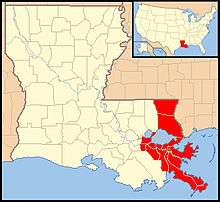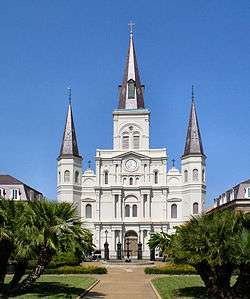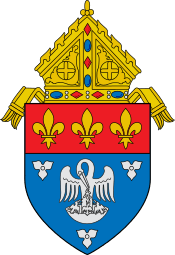Roman Catholic Archdiocese of New Orleans
| Archdiocese of New Orleans Archidioecesis Novae Aureliae Archidiocèse de la Nouvelle-Orléans | |
|---|---|
|
The coat of arms of the Archdiocese of New Orleans | |
| Location | |
| Country | United States |
| Territory | Parishes of Jefferson, Orleans, Plaquemines, St. Bernard, St. Charles, St. John the Baptist, St. Tammany, Washington |
| Ecclesiastical province | Archdiocese of New Orleans |
| Statistics | |
| Area | 4,208 sq mi (10,900 km2) |
| Population - Total - Catholics |
(as of 2013) 1,238,228 520,056 (42%) |
| Parishes | 107 |
| Churches | ~137 |
| Schools | +25 |
| Information | |
| Denomination | Roman Catholic |
| Rite | Roman Rite |
| Established | April 25, 1793 (223 years) |
| Cathedral | Cathedral Basilica of Saint Louis |
| Patron saint |
St. Louis Our Lady of Prompt Succor |
| Secular priests | 387 |
| Current leadership | |
| Pope | Francis |
| Archbishop | Gregory Michael Aymond |
| Emeritus Bishops |
Alfred Clifton Hughes Dominic Carmon, S.V.D. |
| Map | |
 | |
| Website | |
| arch-no.org | |
The Roman Catholic Archdiocese of New Orleans, officially in Latin Archidioecesis Novae Aureliae, is an ecclesiastical division of the Roman Catholic Church administered from New Orleans, Louisiana. It is the second-oldest diocese in the present-day United States, having been elevated to the rank of diocese on April 25, 1793, by Pope Pius VI during Spanish colonial rule. Our Lady of Prompt Succor and St. Louis, King of France are the patron saints of the Archdiocese and Cathedral Basilica of Saint Louis is its mother church as St. Patrick's Church serves as the Pro-Cathedral of the Archdiocese.
Led by an archbishop, the Archdiocese of New Orleans is the center of a larger ecclesiastical province that encompasses the entire state of Louisiana. The Metropolitan Province of New Orleans include the suffragan Dioceses of Alexandria, Baton Rouge, Houma-Thibodaux, Lafayette, Lake Charles, and Shreveport.
On June 12, 2009, Pope Benedict XVI named Bishop Gregory Michael Aymond of the Diocese of Austin to be Archbishop of New Orleans. Archbishop Aymond was installed on August 20, 2009 at Saint Louis Cathedral.
Summary
The archdiocese encompasses eight civil parishes in the New Orleans metropolitan area: Jefferson, Orleans, Plaquemines, St. Bernard, St. Charles, St. John the Baptist, St. Tammany, and Washington. There are 137 church parishes in the archdiocese, ministered by 387 priests (including those belonging to religious institutes), 187 permanent deacons, 84 brothers, and 432 sisters. There are 372,037 Catholics on the census of the Archdiocese, 36% of the total population of the area. The current head of the archdiocese is Archbishop Gregory Michael Aymond. There is one Archbishop Emeritus: Archbishop Alfred Clifton Hughes. There is also one Auxiliary Bishop Emeritus: Bishop Dominic Carmon, S.V.D.
Politics
In early 2009, the state of Maine passed a law allowing same-sex civil marriage. In July 2009 the Roman Catholic Archdiocese of New Orleans contributed $2,000 of its money to a referendum campaign to overturn that law.[1] According to Maine's "Commission on Governmental Ethics & Election Practices", the Roman Catholic Diocese of Portland Maine spent over $553,000 to overturn the law. The Archdiocese of New Orleans' $2,000 was part of that $553,000.[2]
History

The Catholic Church has had a presence in New Orleans since the founding of the city by the French in 1718. New Orleans and the rest of Louisiana west of the Mississippi were surrendered to the Spanish in 1763. From then until 1783 the two Floridas were under British control, but as part of the Peace of Paris (1783) the two Florida colonies were regained from Great Britain. Thus, the pioneer parishes of New Orleans and Louisiana were incorporated into the Diocese of Louisiana and the Two Floridas when it was erected on April 25, 1793. The diocese originally encompassed the entire Louisiana Purchase, from the Gulf of Mexico to British North America, as well as the Florida peninsula and the Gulf Coast.
The date of its establishment makes it the second-oldest diocese in the present-day United States: the Diocese of Baltimore was established on November 6, 1789. At the time of its establishment, the territory of the Diocese of Louisiana and the Two Floridas was part of the Archdiocese of San Cristobal de la Habana, based in Havana, Cuba.
The diocese was divided into smaller dioceses several times, and many modern dioceses in the central United States were originally part of the Diocese of Louisiana. As capital of the Louisiana, the city was sold to the United States in 1803. The diocese was renamed the Diocese of New Orleans in 1826, and encompassed what is now Louisiana and Mississippi. New Orleans was elevated to an archdiocese in 1850. As the population of Louisiana grew, the Archdiocese of New Orleans was further subdivided into several additional dioceses.
In its long history, the Archdiocese and the city of New Orleans have survived several major disasters, including several city-wide fires, a British invasion, the American Civil War, multiple yellow fever epidemics, anti-immigration and anti-Catholicism, the New Orleans Hurricane of 1915, Segregation, Hurricane Betsy, and an occasional financial crisis, not to mention Hurricane Katrina. Each time, the Archdiocese rebuilt damaged churches and rendered assistance to the victims of every disaster. More recently, the church has faced an increased demand for churches in the suburbs and a decline in attendance to inner-city parishes. The church has also weathered changes within the Roman Catholic Church, such as the Second Vatican Council, and changing spiritual values throughout the rest of the United States. [3]
The archdiocese sustained severe damage from Hurricane Katrina and Hurricane Rita. Numerous churches and schools were flooded and battered by hurricane-force winds. In the more heavily flooded neighborhoods, such as St. Bernard Parish, many parish structures were wiped out entirely.[4]
Heritage

The Archdiocese of New Orleans is a culturally diverse community within the diverse city of New Orleans. As a major port, the city has attracted immigrants from around the world. Since French and Spanish Catholics ruled the city, they encouraged enslaved Africans to adopt Christianity. The city has a large population of African American Catholics with deep heritage in the area. Later European immigrants, such as the Irish, Italians, Polish, and German Bavarians have also been a part of the Archdiocese throughout its history. In the last quarter of the 20th century, many Vietnamese Catholics from South Vietnam settled in the city. New waves of immigrants from Mexico, Honduras, Nicaragua and Cuba have added to the Catholic congregations.
Landmarks
The best known church in the New Orleans Archdiocese is the historic St. Louis Cathedral fronting the Spanish Plaza de Armas, now Jackson Square, in the French Quarter. This church was originally built in 1718, shortly after the founding of the city. The modest building was destroyed by fire several times before the current structure was built between 1789 and 1794 during the Spanish domination. During renovations to the cathedral between 1849 and 1851, St. Patrick's Church, the second-oldest parish in the city, served as the pro-cathedral of the archdiocese.
Bishops
The Diocese of Louisiana and the Two Floridas was erected on April 25, 1793; it encompassed the area claimed by Spain as Luisiana, which was all the land draining into the Mississippi River from the west, as well as Spanish territory to the east of the river in modern-day Mississippi, Alabama, and Florida.
- † Luis Ignatius Peñalver y Cárdenas — appointed September 12, 1794 (installed 1795), elevated July 20, 1801 to the see of Guatemala; the first bishop of Louisiana and the Two Floridas.
- † Francisco Porró y Reinado — appointed July 20, 1801, transferred January 17, 1803; never took formal possession of the diocese and was transferred to the see of Tarazona.
In April, 1803, the United States purchased Louisiana from France, which had in 1800 forced Spain to retrocede the territory in the Third Treaty of San Ildefonso. The United States took formal possession of New Orleans on December 20, 1803, and of Upper Louisiana on March 10, 1804. The then-Bishop John Carroll of Baltimore served as apostolic administrator of the diocese from 1805 to 1812; during this period, the diocese became a suffragan of Baltimore. Archbishop Carroll's successor as apostolic administrator would eventually be the diocese's first resident bishop of the 19th century.
- † Louis-Guillaume Dubourg — appointed apostolic administrator, August 18, 1812, appointed bishop September 18, 1815 (installed 1818 at St. Louis), resigned February 2, 1825.
In 1823, Joseph Rosati was appointed coadjutor bishop of the diocese. In 1825, the territory of the diocese in what is now Alabama and Florida was transferred to the new Vicariate Apostolic of Alabama and the Floridas, and in 1826, the diocese was renamed, becoming the Diocese of New Orleans. At the same time, the diocese's territory was further reduced by the creation of the Vicariate Apostolic of Mississippi and the Diocese of St. Louis. Bishop Rosati served as the diocese's apostolic administrator from 1826 to 1829; having been appointed bishop of St. Louis two years previously, he resigned the administration of the New Orleans diocese upon the appointment of Bishop de Neckere.
- † Leo-Raymond de Neckere — appointed August 4, 1829, died September 4, 1833; the first bishop of New Orleans to use that title.
- † Antoine Blanc — appointed June 19, 1835, elevated July 19, 1850; the first archbishop of New Orleans. Upon the elevation of the diocese, its territory outside the state of Louisiana became the Vicariate Apostolic of Indian Territory East of the Rocky Mountains.
† = deceased
Archbishops

- † Antoine Blanc (1850–1860)
- † Jean-Marie Odin (1861–1870)
- † Napoléon-Joseph Perché (1870–1883)
- † Francis Xavier Leray (1883–1887)
- † Francis Janssens (1888–1897)
- † Placide-Louis Chapelle (1897–1905)
- † James Hubert Blenk (1906–1917)
- † John William Shaw (1918–1934)
- † Joseph Francis Rummel (1935–1964)
- † John Patrick Cody (1964–1965)
- † Philip Matthew Hannan (1965–1989)
- † Francis Bible Schulte (1989–2001)
- Alfred Clifton Hughes (2002–2009)
- Gregory Michael Aymond (2009–present)
† = deceased
Auxiliary bishops

- † Gustave Augustin Rouxel (1899-1908); died
- † John Laval (1911-1937); died
- † Louis Abel Caillouet (1947-1976); died
- † Harold Robert Perry, S.V.D. (1966-1991); died
- † Stanley Joseph Ott (1976-1983); named Bishop of Baton Rouge
- Robert William Muench (1990-1996); named Bishop of Covington; current Bishop of Baton Rouge
- Dominic Carmon, S.V.D. (1993–2006); retired
- Gregory Michael Aymond (1997-2000); named Coadjutor bishop of Austin; later returned here, as Archbishop
- Roger Paul Morin (2003-2009); named Bishop of Biloxi
- Shelton Joseph Fabre (2007–2013); named Bishop of Houma-Thibodaux, Louisiana[5]
- Fernand J. Cheri, O.'F.M. (2015- )
† = deceased
Other priests of this diocese who became bishops
Future, to be in chronological order of appointment as bishop
Parishes
The 108 parishes of the archdiocese are divided into 10 deaneries.
Schools
There are 5 Roman Catholic colleges and over 20 high schools within the Archdiocese of New Orleans. Many of the churches throughout the archdiocese have primary schools as well.
Seminaries
Ecclesiastical province of New Orleans
See also
- List of the Roman Catholic dioceses of the United States#Ecclesiastical province of New Orleans
- Category:Roman Catholic Archdiocese of New Orleans
Sources
- ↑ Chuck Colbert (November 25, 2009). "Dioceses major contributors to repeal same-sex marriage". National Catholic Reporter. Kansas City, Missouri. Retrieved November 29, 2009.
- ↑
- ↑ Nolan, Charles E. "A Brief History of the Archdiocese of New Orleans." 2001 May.
- ↑ Finney, Peter. "Devastation." The Clarion Herald. 2005 Oct. 1. Vol. 44, No. 9.
- ↑ http://attualita.vatican.va/sala-stampa/bollettino/2013/09/23/news/31735.html
External links
| Wikimedia Commons has media related to Roman Catholic Archdiocese of New Orleans. |
- Roman Catholic Archdiocese of New Orleans Official Site
- Nolan, Charles E. A History of the Archdiocese of New Orleans May 2001
- Archdiocesan Statistics.
- Catholic Charities of New Orleans.
- The Clarion Herald, the official newspaper of the Archdiocese of New Orleans.
- John and Kathleen DeMajo. Gallery of New Orleans Churches, including numerous Catholic Churches.
- The Catholic Encyclopedia's article for the Archdiocese of New Orleans.
- Organizational website devoted to the opposition of merging Archbishop Blenk and Immaculata high schools
Coordinates: 29°57′27″N 90°06′56″W / 29.95750°N 90.11556°W

